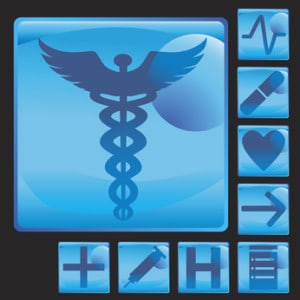
The U.S. Veterans Health Administration (VHA) needed to provide its hospital managers with greater visibility into its onsite equipment to improve coordination, communications and collaboration between caregivers and other staff. This case study explains how they created a real-time location system.
Business Opportunity or Challenge:
The administrators at the VHA needed real-time visibility technologies (versus more passive location technologies) to be able to sense and respond to issues with medical equipment or with refrigeration units used to store medication or lab specimens. Additional requirements included monitoring the sterilization, processing and decontamination workflows in facilities along with tracking cardiac catheterization lab supplies.
How This Business Opportunity or Challenge was Met:
The VHA recently concluded a five-year-long project that brought real-time equipment monitoring to five hospitals and two clinics in Ohio. The effort is part of a rollout of plans to equip all of its 152 hospitals with a Real-Time Location System (RTLS) by using existing Wi-Fi networks.
“RTLS is a long-term initiative to procure and deploy technological solutions for real-time location technologies in VA facilities,” said Kimberly Brayley, Director of the VHA RTLS Project Management Office.
The RTLS has two primary components: a single user interface (UI) that allows for viewing and managing all locating technologies and a national data repository with analytics and business intelligence (BI) tools.
Brayley said the objective is to provide medical centers and other VA facilities with the real-time capability to actively track selected assets, significant medical supplies, staff, patients and environmental conditions (such as temperature and humidity) through a common interface and reporting tool.
In the Ohio phase of the project, the VHA used Radio Frequency Identification (RFID) asset-tracking tags and temperature sensors from Ekahau, Inc. The VHA implemented a total of 10,000 Ekahau active RFID asset-tracking tags for its medical equipment and 750 RFID temperature sensors for its refrigerator units (that store blood, medications and tissues) in order to determine and report temperatures.
The RFID tags enable caregivers across hospital campuses to log in and locate vital equipment on real-time, web-based maps. In addition, staff members receive alerts if a piece of medical equipment nears an exit or other restricted zones.
Ekahau‘s Wi-Fi-based, real-time temperature monitoring solution records and reports temperatures over time. Ekahau sensors also send proactive alarms to pagers, email addresses and an iPhone app if a refrigerator exceeds preprogrammed temperature thresholds in order to prevent loss and spoilage.
The RTLS system operates over the facilities’ existing Wi-Fi networks, bypassing the need for dedicated, cabled network infrastructure or non-standards-based technologies. The system is also redundant, ensuring backups and failovers in order to maintain vital location and temperature data during emergencies.
The larger national plan (to be completed by 2018) is to equip 152 medical centers in the 21 Veteran Integrated Service Networks (VISN) and seven Consolidated Medical Outpatient Pharmacy facilities with real-time location technologies to help identify, locate and monitor assets and supplies within and between facilities.
This facility automation effort (which is overseen by HP Enterprise Services) is intended to improve consistency of services, managerial decision support, and utilization of equipment and staff. It is also designed to help improve customer satisfaction by decreasing operational costs, minimizing lost and misplaced items, reducing delays in patient care, and increasing clinical efficiencies and staff productivity.
Measurable/Quantifiable and “Soft” Benefits from This Initiative:
By having real-time, mapped visibility into equipment locations, biomedical engineers can ascertain equipment utilization rates, right-size ordering and rentals, and optimize maintenance. Caregivers also save time when processing and treating patients who are dependent upon these devices. In addition, VHA hospitals can prevent the accidental loss or misplacement of thousands of dollars in inventory across seven separate medical facilities.
The temperature sensors installed in the refrigeration units also help ensure the safety and integrity of blood, tissue and medications in accordance with The Joint Commission‘s documentation requirements.
Sources: U.S. Veterans Health Administration, Ekahau, Inc; HP Enterprise Services
EDITOR’S NOTE: To submit a case study on behalf of your company, please see our Submission Guidelines and Template for Case Studies.





























